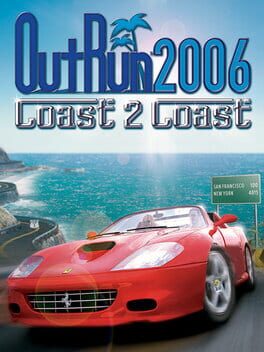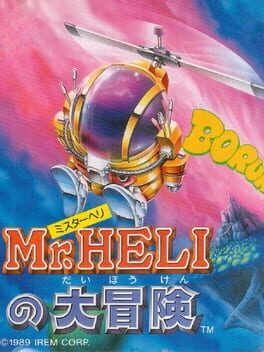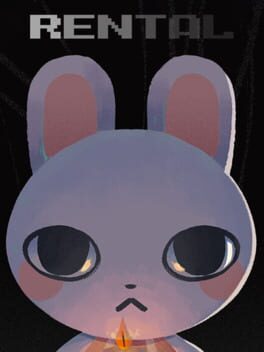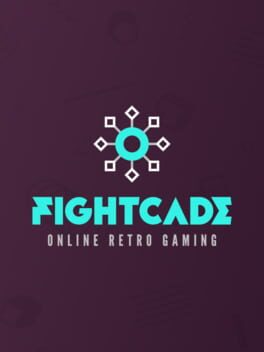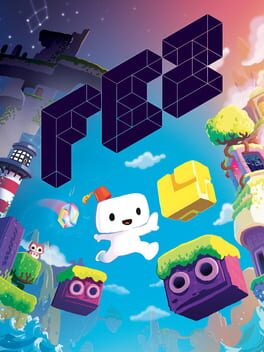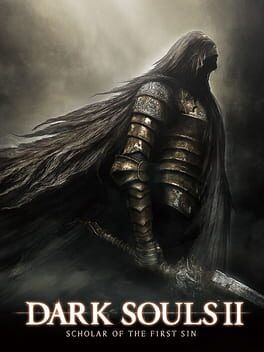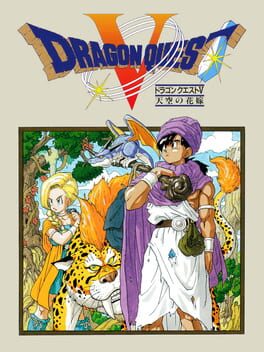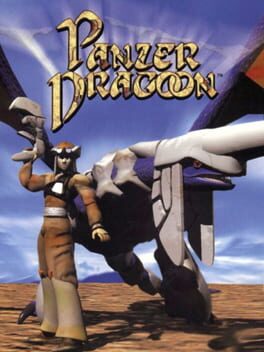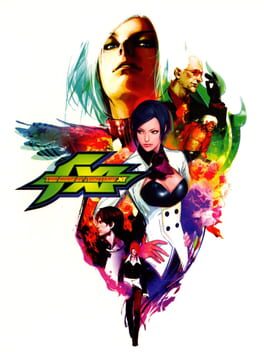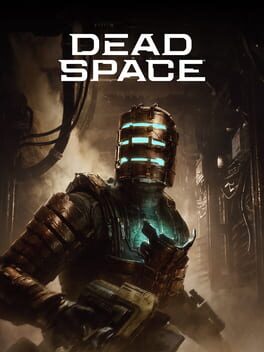5942 Reviews liked by MobileSpider
Mr. Heli
1987
Messy. Feels like a mix between Twinbee and Fantasy Zone, but not as good as either and with the difficulty turned up considerably. A massive difficulty spike with the second boss can give a bad impression, but I wouldn't say its worth continuing after that point anyway. Not awful by any means, but there's not much reason to give this much attention these days.
KinitoPet
2024
I played this for a project I'm working on with some friends and wooooow this is noooot for me lmao.
Analog Horror type beats have never particularly been my thing but I can vibe with a kinda "x but it's off and kinda creepy" type experience especially if it eases you into that experience after instilling a false sense of security with you.
The problem here is that it kinda just goes down the list of the most obvious creepypasta tropes that you could possibly go for from the word go, like you would think that maybe it would hold off on some of its more creepypasta ass shit for at least a little bit but nah, I feel like it's designed that way to keep a youtube/twitch audience engaged (and I mean it has a streamer mode so I definitely think that's what's up).
It especially feels bizarre when the 3rd act of the game actually feels like it does something far creepier and far more interesting with its concept and the kinda connection and trust we allow programs to have on our computers without fully really thinking much about it sometimes.
It just all feels squandered in the way its all wrapped up and presented. Like if this leaned far more into stuff like the complete access/building you something from that, I really think this could've been something way more interesting than it was but I feel the ARG/Youtuber/Streamer/Game Theorist bait it lays out constantly just had me rolling my eyes the entire time.
Defo for a certain audience and hey more power to them but like I need a little more from something like this. I will say, the visual design and audio design though is perfectly done and I do really think that this person has a lot of potential to make something really special.
Also Kinito asked me what my favorite game was, I said Koudelka and he pulled up Control so frankly he's a fraud.
Analog Horror type beats have never particularly been my thing but I can vibe with a kinda "x but it's off and kinda creepy" type experience especially if it eases you into that experience after instilling a false sense of security with you.
The problem here is that it kinda just goes down the list of the most obvious creepypasta tropes that you could possibly go for from the word go, like you would think that maybe it would hold off on some of its more creepypasta ass shit for at least a little bit but nah, I feel like it's designed that way to keep a youtube/twitch audience engaged (and I mean it has a streamer mode so I definitely think that's what's up).
It especially feels bizarre when the 3rd act of the game actually feels like it does something far creepier and far more interesting with its concept and the kinda connection and trust we allow programs to have on our computers without fully really thinking much about it sometimes.
It just all feels squandered in the way its all wrapped up and presented. Like if this leaned far more into stuff like the complete access/building you something from that, I really think this could've been something way more interesting than it was but I feel the ARG/Youtuber/Streamer/Game Theorist bait it lays out constantly just had me rolling my eyes the entire time.
Defo for a certain audience and hey more power to them but like I need a little more from something like this. I will say, the visual design and audio design though is perfectly done and I do really think that this person has a lot of potential to make something really special.
Also Kinito asked me what my favorite game was, I said Koudelka and he pulled up Control so frankly he's a fraud.
Rental
2022
Visually pretty, short little game jam project. Like most of it's kind, Rental is a little rough around the edges but the idea and presentation is strong, I kind of wish it was a full game- or at least extended somewhat with more structure- but that's how these event games usually tend to go. But otherwise, its pretty cute (and free), a perfectly harmless way to kill a few minutes.
FightCade
2015
Fez
2012
If I were to take FEZ at face value, then my thoughts would be pretty brief: it’s a damn good puzzle-platformer game with a hella strong core, taking a 2D interconnected world and twisting it and turning it to achieve greater heights. It’s never particularly difficult or challenging, but it’s fun; reaching new areas is intriguing, and getting the cubes is ultra satisfying, and in a way, I’m kinda glad it never tries to have really hard sections or some sort of final challenge, because even tho I’m sure that’d be cool, and I would really love to see this dimension-shifting mechanic taken up a notch, I also think the way that it is makes the world feel much more organic than it otherwise would, and sells the idea that this is an experience more about the act of exploring than traversing perilous sections.
However, taking FEZ at face value is impossible, or at least it is for me. FEZ is the jumps and beautiful sounds and sights of its adorable ruined worlds as much as it is the secrets that lie within.
I have talked about my fascination with the ancient world and the mysticism and desire to learn that comes with simply witnessing it, whether it is the remnants of a bygone civilization or the remains of an animal that walked the earth hundreds of millions of nights ago. FEZ has a ton of the former and not much of the latter, but what it shares with both of those is that feeling.
The feeling of stumbling upon something you shouldn’t even be able to understand, of seeing the carvings in the wall and the very code that holds reality together and finding answers behind it—it’s satisfying to beat a platforming challenge and get to a chest with a key in it, but it’s equally, if not even more fulfilling, to fit pieces of the puzzle hidden yet in plain sight.
Spirals of purple marble endlessly repeating, secrets to be revealed by feathered friends or written outside of the game itself, tongues that can be completely translated, and moments like what happened to me where I solved a puzzle by complete chance by just fucking around moving some blocks; connecting the deepest secrets of the world through the addition of the Anti-Cubes alone was an amazing decision. Even after pulling apart layers on top of layers to get some of them, I still feel I’ve barely scratched the surface of what’s in here, what can be found, like an excavation that just has begun.
Every step is a new discovery, and making it to each of the main hub worlds opens a new horizon, from the oldest depths to the stormiest peaks, and it’s all so… tranquil. The wonderful, beautiful pixel art mixed with the outstanding OST, it compels you to keep going, to see juuuuuuuuuuuuuuuust a lil’ more, to keep going a bit further, only to be met with a teleporter, going back to the hub, and repeating that process over and over again. It says a lot when, in the year 2024, a game that uses QR codes or 4th wall breaks to solve puzzles doesn’t make me groan; on the contrary, in fact, it manages to fit into that secret uncovering process tremendously well.
There are pieces that don’t quite fit: the fact that quite a few of those more hidden puzzles end up being a combination of LT and LR inputs is a bit disappointing and misses the mark on what other Anit-Cube quests accomplish so well, and there’s some even weirder stuff like annoying void squares that appear randomly and aren’t anything more than a dumb annoyance or how entering doors may just crash to desktop randomly, which isn’t part of the experience, mind you, and it takes you completely out of it sometimes. It only happened once to me, but this being a problem present years later is a bit disappointing, to be honest.
It's a cube quest that a few times can be a little disappointing or frustrating, but that’s something I can easily look past when the rest of it is so stellar that the act of opening doors is the most exciting fucking thing ever. It invites to wonder and imagine, and there’s so much to be solved and found that, after hitting credits, I feel like the exploration can go even further… Oh, and also, Gomez’s design and name is the best fucking thing ever and there’s no contest, the most basic-ass lil white dude and I love it, look at his smile!
Adventure is out there, and it carries mysteries with it, it’s about time someone solves them.
However, taking FEZ at face value is impossible, or at least it is for me. FEZ is the jumps and beautiful sounds and sights of its adorable ruined worlds as much as it is the secrets that lie within.
I have talked about my fascination with the ancient world and the mysticism and desire to learn that comes with simply witnessing it, whether it is the remnants of a bygone civilization or the remains of an animal that walked the earth hundreds of millions of nights ago. FEZ has a ton of the former and not much of the latter, but what it shares with both of those is that feeling.
The feeling of stumbling upon something you shouldn’t even be able to understand, of seeing the carvings in the wall and the very code that holds reality together and finding answers behind it—it’s satisfying to beat a platforming challenge and get to a chest with a key in it, but it’s equally, if not even more fulfilling, to fit pieces of the puzzle hidden yet in plain sight.
Spirals of purple marble endlessly repeating, secrets to be revealed by feathered friends or written outside of the game itself, tongues that can be completely translated, and moments like what happened to me where I solved a puzzle by complete chance by just fucking around moving some blocks; connecting the deepest secrets of the world through the addition of the Anti-Cubes alone was an amazing decision. Even after pulling apart layers on top of layers to get some of them, I still feel I’ve barely scratched the surface of what’s in here, what can be found, like an excavation that just has begun.
Every step is a new discovery, and making it to each of the main hub worlds opens a new horizon, from the oldest depths to the stormiest peaks, and it’s all so… tranquil. The wonderful, beautiful pixel art mixed with the outstanding OST, it compels you to keep going, to see juuuuuuuuuuuuuuuust a lil’ more, to keep going a bit further, only to be met with a teleporter, going back to the hub, and repeating that process over and over again. It says a lot when, in the year 2024, a game that uses QR codes or 4th wall breaks to solve puzzles doesn’t make me groan; on the contrary, in fact, it manages to fit into that secret uncovering process tremendously well.
There are pieces that don’t quite fit: the fact that quite a few of those more hidden puzzles end up being a combination of LT and LR inputs is a bit disappointing and misses the mark on what other Anit-Cube quests accomplish so well, and there’s some even weirder stuff like annoying void squares that appear randomly and aren’t anything more than a dumb annoyance or how entering doors may just crash to desktop randomly, which isn’t part of the experience, mind you, and it takes you completely out of it sometimes. It only happened once to me, but this being a problem present years later is a bit disappointing, to be honest.
It's a cube quest that a few times can be a little disappointing or frustrating, but that’s something I can easily look past when the rest of it is so stellar that the act of opening doors is the most exciting fucking thing ever. It invites to wonder and imagine, and there’s so much to be solved and found that, after hitting credits, I feel like the exploration can go even further… Oh, and also, Gomez’s design and name is the best fucking thing ever and there’s no contest, the most basic-ass lil white dude and I love it, look at his smile!
Adventure is out there, and it carries mysteries with it, it’s about time someone solves them.
I'm probably going to repeat a lot of similar points that Larry Davis brought up in his review, so... what he said.
14 years after The Forgotten Sands, Prince of Persia is finally back, and the folks over at Ubisoft Monpellier understood the assignment: crap up good movement and puzzle solving with dreadful combat and an over-reliance on mobs of spongy enemies.
Parrying and punishing is the bread and butter of Sargon's kit, a rhythm you want to maintain to build meter for more devastating abilities, but when you're just trying to get to your next objective or explore some crypt, constantly getting beaned from all sides by low-level goons that have a bafflingly high HP pool gets really annoying. You might think bosses better leverage this system being that they're one-on-one encounters, but most fall into the same rote strategy of playing defensively until they open themselves up for a cinematic counter.
At least one of these bosses actively punishes dynamic play by spamming teleports and parries when the player behaves aggressively, resulting in a fight that requires you sit Sargon in a corner so the boss will fall into a pattern of throwing out the same three attacks, permitting you to plink away at his health at the end of each sequence. I'm pretty sure this isn't an intentional lesson so much as the AI doesn't know how to deal with you remaining still, but I would describe combat as being bizarrely passive despite how much you're given to work with.
The pendulum does eventually swing in the other direction when you gather up enough ingots to upgrade Sargon's weapons, but enemies never quite keep pace with the player's growth, resulting in a game that's entirely too frustrating in the early half and almost comically easy in the second.
And sure, you might argue that a search-action game is all about making the player feel progressively more empowered as they plumb the depths of whatever hostile labyrinth they're trapped in, but almost all the gains Sargon actually makes are bought and paid for with time crystals. In Super Metroid, Samus slowly gains abilities and expands her inventory through exploration. In Symphony of the Night, Alucard can find a variety of capes, armors, and weapons that allows the player to directly build their character. While The Lost Crown's most secluded areas occasionally house a heart container or equipable charm (most of which are borderline useless), they'll more often dead end with 40 crystals and a piece of paper with a full length Backloggd essay written on it -- I ain't reading that, I don't have time! Growth feels far more tied to the economics of the world and what you can afford than it does exploration. Hell, sometimes you'll even go out of your way to reach a secret alcove and find there's nothing at all.
Before I punch out from my shift at the hot take factory, where I work as a foreman to support my factory wife and my 2.5 factory kids, I will say that Lost Crown is a much more enjoyable experience when you decouple yourself from the typical search-action loop of exploring every nook and cranny and instead focus on the main path. There's some genuinely great platforming sequences and puzzles that make good use of Sargon's traversal abilities, and the layout of Mount Qaf is easy to read and navigate your way through thanks to the game setting objective markers and allowing you to photograph areas of interest for quick reference on the map.
The story has its share of contrivances, especially early on, but I did find myself surprisingly invested by the end of the game, and although most characters can be described as "well-meaning but criminally and suicidally stupid," the concept of Mount Qaf existing within a bubble of fractured space and time is enough to carry the narrative whenever the character writing falls short. I really like the idea that every character and NPC is perceiving time differently, some being displaced by decades whereas others are made to exist within a singular moment for eternity.
Lost Crown doesn't stick the landing for me. It gets a lot about the search-action formula wrong, particularly with character growth and incentivizing exploration off the beaten path. The combat is rough and excessive, and sometimes you'll spend ten minutes throwing yourself to a meat grinder trial-and-erroring your way through pattern memorization all for a pair of pants, but there's still something here. Traversal feels good, the visual design is great, and the core loop is satisfying enough to elevate Lost Crown from being a bad game to being perfectly mediocre, maybe even serviceable. In other words, it's a Prince of Persia game.
Gonna buy a shirt that says "I'd rather be playing Touhou Luna Nights."
14 years after The Forgotten Sands, Prince of Persia is finally back, and the folks over at Ubisoft Monpellier understood the assignment: crap up good movement and puzzle solving with dreadful combat and an over-reliance on mobs of spongy enemies.
Parrying and punishing is the bread and butter of Sargon's kit, a rhythm you want to maintain to build meter for more devastating abilities, but when you're just trying to get to your next objective or explore some crypt, constantly getting beaned from all sides by low-level goons that have a bafflingly high HP pool gets really annoying. You might think bosses better leverage this system being that they're one-on-one encounters, but most fall into the same rote strategy of playing defensively until they open themselves up for a cinematic counter.
At least one of these bosses actively punishes dynamic play by spamming teleports and parries when the player behaves aggressively, resulting in a fight that requires you sit Sargon in a corner so the boss will fall into a pattern of throwing out the same three attacks, permitting you to plink away at his health at the end of each sequence. I'm pretty sure this isn't an intentional lesson so much as the AI doesn't know how to deal with you remaining still, but I would describe combat as being bizarrely passive despite how much you're given to work with.
The pendulum does eventually swing in the other direction when you gather up enough ingots to upgrade Sargon's weapons, but enemies never quite keep pace with the player's growth, resulting in a game that's entirely too frustrating in the early half and almost comically easy in the second.
And sure, you might argue that a search-action game is all about making the player feel progressively more empowered as they plumb the depths of whatever hostile labyrinth they're trapped in, but almost all the gains Sargon actually makes are bought and paid for with time crystals. In Super Metroid, Samus slowly gains abilities and expands her inventory through exploration. In Symphony of the Night, Alucard can find a variety of capes, armors, and weapons that allows the player to directly build their character. While The Lost Crown's most secluded areas occasionally house a heart container or equipable charm (most of which are borderline useless), they'll more often dead end with 40 crystals and a piece of paper with a full length Backloggd essay written on it -- I ain't reading that, I don't have time! Growth feels far more tied to the economics of the world and what you can afford than it does exploration. Hell, sometimes you'll even go out of your way to reach a secret alcove and find there's nothing at all.
Before I punch out from my shift at the hot take factory, where I work as a foreman to support my factory wife and my 2.5 factory kids, I will say that Lost Crown is a much more enjoyable experience when you decouple yourself from the typical search-action loop of exploring every nook and cranny and instead focus on the main path. There's some genuinely great platforming sequences and puzzles that make good use of Sargon's traversal abilities, and the layout of Mount Qaf is easy to read and navigate your way through thanks to the game setting objective markers and allowing you to photograph areas of interest for quick reference on the map.
The story has its share of contrivances, especially early on, but I did find myself surprisingly invested by the end of the game, and although most characters can be described as "well-meaning but criminally and suicidally stupid," the concept of Mount Qaf existing within a bubble of fractured space and time is enough to carry the narrative whenever the character writing falls short. I really like the idea that every character and NPC is perceiving time differently, some being displaced by decades whereas others are made to exist within a singular moment for eternity.
Lost Crown doesn't stick the landing for me. It gets a lot about the search-action formula wrong, particularly with character growth and incentivizing exploration off the beaten path. The combat is rough and excessive, and sometimes you'll spend ten minutes throwing yourself to a meat grinder trial-and-erroring your way through pattern memorization all for a pair of pants, but there's still something here. Traversal feels good, the visual design is great, and the core loop is satisfying enough to elevate Lost Crown from being a bad game to being perfectly mediocre, maybe even serviceable. In other words, it's a Prince of Persia game.
Gonna buy a shirt that says "I'd rather be playing Touhou Luna Nights."
There was a brief period where I was ready to jump on the 'Dark Souls 2 is underrated' train but then it just continued to hit me with underwhelming boss after underwhelming boss. I understand some fans prefer when the series leans harder into the RPG side of 'Action-RPG' but I'm really just here for the action and while some fights/areas delivered on this fairly well, a majority of them can be brute forced far too easily simply by having enough levels under your belt.
On a more positive note, the atmosphere here is unique and interesting, there's a pretty diverse range of locations (especially when including the DLC), and the NPCs are some of the most memorable in the series. I also actually enjoyed a majority of the additional enemies that were thrown into SotFS to make things a little more difficult; I don't want to imagine how bland some of these areas would've been without them.
At the end of the day, a souls game is a souls game and I had a good enough time working my way through Dark Souls 2 but this is easily the least impressed I've been with any entry in the series. (Insert joke about how DS2 is just an Elden Ring prototype here)
On a more positive note, the atmosphere here is unique and interesting, there's a pretty diverse range of locations (especially when including the DLC), and the NPCs are some of the most memorable in the series. I also actually enjoyed a majority of the additional enemies that were thrown into SotFS to make things a little more difficult; I don't want to imagine how bland some of these areas would've been without them.
At the end of the day, a souls game is a souls game and I had a good enough time working my way through Dark Souls 2 but this is easily the least impressed I've been with any entry in the series. (Insert joke about how DS2 is just an Elden Ring prototype here)
I wasn’t intending on making a review for this game but I decided to change my mind and give this one a nice review. I’ve always been terrible at trying to just finish these DQ games despite XI being such a great game. I decided to play the fifth entry because I know how popular it was though had I done this later, I probably would have done II instead. Regardless, let me tell you why DQ V is such a great game.
While this game is old, I don’t really want to spoil much of the story as I think it’s something that should be experienced if you have an interest in the game. The story however did surprise me, I was expecting it to be pretty basic and would work for the most part of the time. There’s so many eye opening moments and even times that got a big reaction out of me. While I don’t find the characters as memorable as other RPGs, a lot of them are still good for the game and I’m happy to find the writing to be one of the highlights of the game. There’s even some nice humor at times. It’s just overall very good.
The gameplay is also pretty fun and rarely has dull moments. One neat mechanic of DQ V has to be recruiting specific monsters from the overworld or dungeons to put on your team. I used a few of them and I’d say my favorite one was the Curer just to have a convenient healall user if I needed it. Battles require some thought and you’ll have to make use of buffs, debuffs, and statuses to win some later fights. You don’t even need to grind all that much in the game, I only did it like a few times though it might vary for others. I love all the different types of spells to use too but it does make it stressful to sometimes not go overboard and run out. If there was one thing I regret was not buying more Elven magic from the casino. I did at least prepare for the last part of the game.
The world is vast in the game and there’s a lot of places to visit and discover. One thing I love about the overworld is just the many ways to travel in it. You can go on foot, travel by ship, magic carpet, a floating castle, and even a dragon. I did find myself getting lost a few times but I did get used to it for the most part. I wish the return spell would let you travel to any location you’ve been to, it seems to be picky about where it’ll save locations for you. While the game visually might be a little repetitive for some of the locations, there’s still a lot here and it was always a curiosity to check what’s new.
The dungeon design in this game is pretty good and not much of it is that annoying or bad. It’s fun to explore these and get items and fight tough enemies. I do wish more bosses were in them though, it feels like a lot of the time you don’t fight them. There’s some memorable places like the haunted location early in the game, a cave with minecarts to ride, and a volcano with lava floors that hurt. Wait, Final Fantasy 1 already did that last one, hmm. You also sometimes can’t bring your caravan in for these places so make sure you set out a good team for this before going in. I swear a lot of the 2nd half makes you do this.
Ok I know I said to let you experience the story for yourself but one thing that was on my mind a few times was the marriage thing. You’ll try to get an item related to your quest but are forced to marry a girl by the name of Flora. By the time you’re almost done, you meet up with Bianca as she’s aged up since you last met her in your childhood years. Now I for one thought it was very obvious where they were going with this and I was expecting them to truly fall in love. When you finally get the rings, you get this plot point where the Hero struggles between the two with even a restless night and I’m just thinking “What? Why would I not choose Bianca?” I almost felt like this was just gonna force her anyway but obviously I was going to pick her. It wasn’t till later I looked it up and found out you can marry her! With some of the parts in the story, that just feels wrong. Maybe I just don’t get it? Just feels like the wrong choice to me.
There are some small nitpicks I have with the game. I really don’t like the item management with this game and how picky it is with them wanting items in a character’s inventory to use. I also felt the encounter rate at times could be a little annoying at times. This point I’m gonna bring up isn’t a problem with the game but I felt by the 2nd half, my team basically stayed the same and I felt kind of discouraged to try other ideas because what I had was working fine. There’s also some characters you can use and I find confusing why you would want to unless I’m missing something. I think it’s partially why a lot of the characters don’t feel the most memorable in my heart if that makes sense. Still, again these are nitpicks and it says a lot about the game that these are really some of my only few negatives.
Visually the game looks pretty nice for a 1992 RPG. I think the battle screens are the highlight because they actually take place in locations just like the first DQ game on Famicom. Those designs by Akira Toriyama are also just splendid here. The music is also pretty good and almost feels like I can hear the orchestra even if it’s obviously still just the SFC sound chip. I especially love the two dungeon themes you hear in the game the most. I also really love the music when you’re sailing. Even the sound effects sound pretty nice for the hardware. It’s all worth a listen if you ever have the time.
I’m happy to have finally finished this game and see it rank so high. Sure it may not be my favorite 16 bit RPG as of writing this but still being such a great game is no slouch either. You probably know already just how popular this game is and it’s very easy to see why now that I’ve played it all the way through. There are various ways to play the game now. It was first remade in 3D on the PS2 and then a more enhanced 2D version was made for the DS. The DS version was the first time it was localized too so you’ll need a fan translation to play the original or the 3D remake. It also has a version for mobile phones. Oddly it’s never been ported since which feels very odd considering the Switch’s success. A movie based on this game also exists called Dragon Quest: Your Story. Never watched it though, maybe I should. The series would only get one more sequel on the system which is kind of shocking considering how well this one did. When I watched the credits of the game, I really felt moved at reminiscing about the journey I had. It’s kind of crazy to think I played this in memory of Toriyama as he has now passed away and seeing his name makes me miss him again. Bless him and all of the talent who worked on this game. Dragon Quest V is a great game and it’s a game I’ll probably play again someday.
While this game is old, I don’t really want to spoil much of the story as I think it’s something that should be experienced if you have an interest in the game. The story however did surprise me, I was expecting it to be pretty basic and would work for the most part of the time. There’s so many eye opening moments and even times that got a big reaction out of me. While I don’t find the characters as memorable as other RPGs, a lot of them are still good for the game and I’m happy to find the writing to be one of the highlights of the game. There’s even some nice humor at times. It’s just overall very good.
The gameplay is also pretty fun and rarely has dull moments. One neat mechanic of DQ V has to be recruiting specific monsters from the overworld or dungeons to put on your team. I used a few of them and I’d say my favorite one was the Curer just to have a convenient healall user if I needed it. Battles require some thought and you’ll have to make use of buffs, debuffs, and statuses to win some later fights. You don’t even need to grind all that much in the game, I only did it like a few times though it might vary for others. I love all the different types of spells to use too but it does make it stressful to sometimes not go overboard and run out. If there was one thing I regret was not buying more Elven magic from the casino. I did at least prepare for the last part of the game.
The world is vast in the game and there’s a lot of places to visit and discover. One thing I love about the overworld is just the many ways to travel in it. You can go on foot, travel by ship, magic carpet, a floating castle, and even a dragon. I did find myself getting lost a few times but I did get used to it for the most part. I wish the return spell would let you travel to any location you’ve been to, it seems to be picky about where it’ll save locations for you. While the game visually might be a little repetitive for some of the locations, there’s still a lot here and it was always a curiosity to check what’s new.
The dungeon design in this game is pretty good and not much of it is that annoying or bad. It’s fun to explore these and get items and fight tough enemies. I do wish more bosses were in them though, it feels like a lot of the time you don’t fight them. There’s some memorable places like the haunted location early in the game, a cave with minecarts to ride, and a volcano with lava floors that hurt. Wait, Final Fantasy 1 already did that last one, hmm. You also sometimes can’t bring your caravan in for these places so make sure you set out a good team for this before going in. I swear a lot of the 2nd half makes you do this.
Ok I know I said to let you experience the story for yourself but one thing that was on my mind a few times was the marriage thing. You’ll try to get an item related to your quest but are forced to marry a girl by the name of Flora. By the time you’re almost done, you meet up with Bianca as she’s aged up since you last met her in your childhood years. Now I for one thought it was very obvious where they were going with this and I was expecting them to truly fall in love. When you finally get the rings, you get this plot point where the Hero struggles between the two with even a restless night and I’m just thinking “What? Why would I not choose Bianca?” I almost felt like this was just gonna force her anyway but obviously I was going to pick her. It wasn’t till later I looked it up and found out you can marry her! With some of the parts in the story, that just feels wrong. Maybe I just don’t get it? Just feels like the wrong choice to me.
There are some small nitpicks I have with the game. I really don’t like the item management with this game and how picky it is with them wanting items in a character’s inventory to use. I also felt the encounter rate at times could be a little annoying at times. This point I’m gonna bring up isn’t a problem with the game but I felt by the 2nd half, my team basically stayed the same and I felt kind of discouraged to try other ideas because what I had was working fine. There’s also some characters you can use and I find confusing why you would want to unless I’m missing something. I think it’s partially why a lot of the characters don’t feel the most memorable in my heart if that makes sense. Still, again these are nitpicks and it says a lot about the game that these are really some of my only few negatives.
Visually the game looks pretty nice for a 1992 RPG. I think the battle screens are the highlight because they actually take place in locations just like the first DQ game on Famicom. Those designs by Akira Toriyama are also just splendid here. The music is also pretty good and almost feels like I can hear the orchestra even if it’s obviously still just the SFC sound chip. I especially love the two dungeon themes you hear in the game the most. I also really love the music when you’re sailing. Even the sound effects sound pretty nice for the hardware. It’s all worth a listen if you ever have the time.
I’m happy to have finally finished this game and see it rank so high. Sure it may not be my favorite 16 bit RPG as of writing this but still being such a great game is no slouch either. You probably know already just how popular this game is and it’s very easy to see why now that I’ve played it all the way through. There are various ways to play the game now. It was first remade in 3D on the PS2 and then a more enhanced 2D version was made for the DS. The DS version was the first time it was localized too so you’ll need a fan translation to play the original or the 3D remake. It also has a version for mobile phones. Oddly it’s never been ported since which feels very odd considering the Switch’s success. A movie based on this game also exists called Dragon Quest: Your Story. Never watched it though, maybe I should. The series would only get one more sequel on the system which is kind of shocking considering how well this one did. When I watched the credits of the game, I really felt moved at reminiscing about the journey I had. It’s kind of crazy to think I played this in memory of Toriyama as he has now passed away and seeing his name makes me miss him again. Bless him and all of the talent who worked on this game. Dragon Quest V is a great game and it’s a game I’ll probably play again someday.
FightCade
2015
The art in this game is beautiful, and the concept is very sweet, though as much as I would want to love a Touhou rpgmaker game the translation is kind of patchy and they made me do complex math. The puzzles alternate between being easy to frustrating, either way they're all very simple in concept and it isnt anything that excites me, or really relates to Touhou at all for that matter. I dont think any game ever should make you pay 8 dollars just to humiliate yourself doing division.
Panzer Dragoon
1995
The first few minutes of Panzer Dragoon when your blue dragon majestically soars above the rippling water to the tune of Flight define a classic video game introduction that I doubt I will ever forget. A part of me expected the experience to be steadily downhill from there given the common complaints that I’ve heard, but to the game’s credit, it quickly established its defining hook and never let go. Panzer Dragoon was one of the first games to take total advantage of its 3D space, and it does so through its ability to rotate the player’s aim in 360 degrees. The catch is that while you can’t aim sideways/behind the dragon when looking forward, there’s a trade-off in that you can’t steer the dragon and change its mid-air position while in first-person aiming around the sides of/behind its body. As a result, there’s a precise science to swapping between these two camera modes. The macro never gets complex (shoot everything in sight while dodging and shooting down enemy attacks), but the micro is just involved enough to where there’s little downtime as you constantly peruse your surroundings and systematically pick off your foes. This is a game that wants the player to be aware of everything around them, and Team Andromeda was more than happy to let them soak in the sights given that the minimalist UI (simply consisting of a radar for spotting enemies and a player health bar) never really gets in the way. Even today, I find Panzer Dragoon to be an absolutely gorgeous game, and I can only imagine how people in 1995 felt playing this for the first time.
I’ve been warned that Panzer Dragoon’s difficulty can be a significant roadblock, but after a few playthroughs, I think it’s definitely conquerable. Besides mastering control of the player reticle/camera, players need to recognize when to utilize the homing laser lock-on (holding down the fire button) versus mashing to quickly fire the player’s handgun. The homing laser is great for getting rid of enemy swarms and easily targeting moving foes, while the handgun is a godsend for melting beefy mobs and bosses while sniping faraway targets that can’t be locked onto. In particular, Episode 3’s jumping ship boss is a notable chump check if you refuse to lock-on, while Episode 5’s airships will overwhelm you if you don’t mash. Additionally, I’ve also heard that Panzer Dragoon can feel very unforgiving since the player is allowed only one game-over before they have to restart a run, and the game only regenerates half of the player's health upon completing a level. However, given that the player can earn an extra credit per stage if they manage to shoot down more than 85% of the enemies in a single episode, I'd say there’s enough leeway given if the player takes the time to master its controls and meticulously defeat enough enemies instead of simply playing entirely defensive.
The only real gripe that I’d have is that enemy attacks sometimes blend into the background (ex: black cannonballs on top of dark environments) and can be tough to spot, especially when obscured by smoke effects from already defeated airships. I can still dodge most of these attacks with enough experience, having learning the enemy spawn positions, though it takes time to master given that players need to adapt to the game’s weightiness and natural response time. After all, you’re controlling a rider controlling a dragon rather than controlling the dragon itself, so it takes a bit more time to shift the model away from incoming barrages. As is, I’d still prefer if all enemy attacks were distinctly colored to stand out from both my own projectiles and the surroundings. Regardless, Panzer Dragoon was a breath of fresh air and I don’t mind its relative simplicity or brevity when it manages to succinctly capture an enthralling rail-shooting experience that I’ll gladly replay just to see myself visibly improve with every new run. All I can say is that this was certainly no flight of fancy; if the base model was this good, then I can’t wait to see what Team Andromeda/Smilebit have to offer with Zwei and Orta.
I’ve been warned that Panzer Dragoon’s difficulty can be a significant roadblock, but after a few playthroughs, I think it’s definitely conquerable. Besides mastering control of the player reticle/camera, players need to recognize when to utilize the homing laser lock-on (holding down the fire button) versus mashing to quickly fire the player’s handgun. The homing laser is great for getting rid of enemy swarms and easily targeting moving foes, while the handgun is a godsend for melting beefy mobs and bosses while sniping faraway targets that can’t be locked onto. In particular, Episode 3’s jumping ship boss is a notable chump check if you refuse to lock-on, while Episode 5’s airships will overwhelm you if you don’t mash. Additionally, I’ve also heard that Panzer Dragoon can feel very unforgiving since the player is allowed only one game-over before they have to restart a run, and the game only regenerates half of the player's health upon completing a level. However, given that the player can earn an extra credit per stage if they manage to shoot down more than 85% of the enemies in a single episode, I'd say there’s enough leeway given if the player takes the time to master its controls and meticulously defeat enough enemies instead of simply playing entirely defensive.
The only real gripe that I’d have is that enemy attacks sometimes blend into the background (ex: black cannonballs on top of dark environments) and can be tough to spot, especially when obscured by smoke effects from already defeated airships. I can still dodge most of these attacks with enough experience, having learning the enemy spawn positions, though it takes time to master given that players need to adapt to the game’s weightiness and natural response time. After all, you’re controlling a rider controlling a dragon rather than controlling the dragon itself, so it takes a bit more time to shift the model away from incoming barrages. As is, I’d still prefer if all enemy attacks were distinctly colored to stand out from both my own projectiles and the surroundings. Regardless, Panzer Dragoon was a breath of fresh air and I don’t mind its relative simplicity or brevity when it manages to succinctly capture an enthralling rail-shooting experience that I’ll gladly replay just to see myself visibly improve with every new run. All I can say is that this was certainly no flight of fancy; if the base model was this good, then I can’t wait to see what Team Andromeda/Smilebit have to offer with Zwei and Orta.
Metroid Fusion
2002
the discomfort zone got too comfortable so we made the comfort zone discomfortable. samus: meet samus
where super dove uncritically into the power fantasy that metroid II (the game with a literal Genocide Counter in the UI) unmasked and deflated, this feels like it's turning it inward against you personally. Your body, Your likeness, and Your autonomy hijacked; Your celebratory past tense role as (repeated) casual annihilationist to reckon with and cower from
it operates as something of a Super Negative Image Metroid: an inversion right down to the uncomfortable, choking grip of the direction. all that clammy ADAMsplaining, those sequestered zones, the redline urgency; everything's dialed perfectly into the exact same channel with uniform intent. even the woozy alien psychedelia's been spirited away in favour of clinical, detached interiors and astroturfed xerox biomes with some of the most appropriately sterile Oops No Backlight lighting on the GBA
and no, it obviously doesn't accomplish the same things as its predecessors, but it's not attempting to. this is a game about lack of control, and altering the format would be akin to breaking the spinal column that holds it upright. fusion's big successes (the pacing, brevity, tonal and thematic consonance, and delicate curation of tension and challenge) are the result of its structural changes. being shunted around a tiny sarcophagus isn't a flaw, it's the entire premise. duh
even without all that though it's impossible for me not to love a game with nightmare, the Profaned Baja Blast Suit, AQA's sunken banger, shots like this, and those absolutely psychotic ridley screams
quite possibly the best SA-X heavy fusion since the sultry sounds of steely dan
where super dove uncritically into the power fantasy that metroid II (the game with a literal Genocide Counter in the UI) unmasked and deflated, this feels like it's turning it inward against you personally. Your body, Your likeness, and Your autonomy hijacked; Your celebratory past tense role as (repeated) casual annihilationist to reckon with and cower from
it operates as something of a Super Negative Image Metroid: an inversion right down to the uncomfortable, choking grip of the direction. all that clammy ADAMsplaining, those sequestered zones, the redline urgency; everything's dialed perfectly into the exact same channel with uniform intent. even the woozy alien psychedelia's been spirited away in favour of clinical, detached interiors and astroturfed xerox biomes with some of the most appropriately sterile Oops No Backlight lighting on the GBA
and no, it obviously doesn't accomplish the same things as its predecessors, but it's not attempting to. this is a game about lack of control, and altering the format would be akin to breaking the spinal column that holds it upright. fusion's big successes (the pacing, brevity, tonal and thematic consonance, and delicate curation of tension and challenge) are the result of its structural changes. being shunted around a tiny sarcophagus isn't a flaw, it's the entire premise. duh
even without all that though it's impossible for me not to love a game with nightmare, the Profaned Baja Blast Suit, AQA's sunken banger, shots like this, and those absolutely psychotic ridley screams
quite possibly the best SA-X heavy fusion since the sultry sounds of steely dan
Dead Space
2023
Inessential.
Despite the many quality-of-life changes meant to bring this more in line with the rest of the series, like updating the Zero-G sections and letting you use your kinesis more offensively, the broad strokes of the game are surprisingly close to the original. A change I was really looking forward to was the “Intensity Director” which is meant to dynamically alter the mood of areas and what enemies will spawn, but in practice, this mostly seems to determine whether or not you’ll get ambushed while backtracking instead of radically altering the major combat encounter. It’s a nice thrill to occasionally get surrounded by enemies, but as with so many of the new features of the remake, it doesn’t wholly commit to this idea, more a proof-of-concept that could be really transformative if it was expanded on somewhere else. Basic Necromorphs are also substantially less threatening due to the fact that it’s surprisingly easy to stunlock them by stomping on them once their legs have been shot out, and for the sheer effectiveness of these newly revamped kinesis powers (encounters and the ammo economy needed to be dramatically changed to make threats meaningful the player).
Given that this production seems to owe so much to the success of the recent Resident Evil remakes, I wish it would’ve taken a cue from them and include some bolder pieces of design and pacing- throw in an extra Regenerator fight, change the order of levels, or go all the way and pull the best enemies from the entire series to give these fights an extra edge. There are earnest discussions to be had about what function the RE remakes serve (if they’re replacements or reimaginings) but at least they’re distinct- I’m compelled to go back to them from time to time!
Really, I think the hesitance to change to radically alter the structure and encounter design speaks to the real intent of this remake, which seems far more interested in making the narrative flow more seamlessly between this and Dead Space 2. Isaac Clarke more or less had to be invented as a character in the sequel, and that made the amount of screentime that was devoted to his guilt over Nicole all the more weightless- retconned baggage that hardly landed. The attempt to expand their relationship mostly works, the revelations here about how their relationship ended are much better about setting the groundwork for their arc in the sequel. For as strong as this dynamic, it seems to have come at the cost of much of the supporting cast; compared to their original versions, everyone on the Ishimura comes as the lifeless versions of themselves. Dr. Kyne and Dr. Mercer were amazing presences thanks to great performances by Keith Szarabajka and Navid Negahban respectively, but without that prior context, I’m not sure these new iterations of the characters will stay in the minds of those who’ve only played the remake.
The biggest sin is that the remake ends up being dreadfully boring to play through in practice, the threats so similar to the original that the horror doesn’t land and the action so easy to break that it actively feels like a regression from the constraints of the earlier version of combat design. There’s obvious passion for the project here, especially in some of the granular details, but seemingly not the broader vision needed to successfully combine the old and new ideas together.
Despite the many quality-of-life changes meant to bring this more in line with the rest of the series, like updating the Zero-G sections and letting you use your kinesis more offensively, the broad strokes of the game are surprisingly close to the original. A change I was really looking forward to was the “Intensity Director” which is meant to dynamically alter the mood of areas and what enemies will spawn, but in practice, this mostly seems to determine whether or not you’ll get ambushed while backtracking instead of radically altering the major combat encounter. It’s a nice thrill to occasionally get surrounded by enemies, but as with so many of the new features of the remake, it doesn’t wholly commit to this idea, more a proof-of-concept that could be really transformative if it was expanded on somewhere else. Basic Necromorphs are also substantially less threatening due to the fact that it’s surprisingly easy to stunlock them by stomping on them once their legs have been shot out, and for the sheer effectiveness of these newly revamped kinesis powers (encounters and the ammo economy needed to be dramatically changed to make threats meaningful the player).
Given that this production seems to owe so much to the success of the recent Resident Evil remakes, I wish it would’ve taken a cue from them and include some bolder pieces of design and pacing- throw in an extra Regenerator fight, change the order of levels, or go all the way and pull the best enemies from the entire series to give these fights an extra edge. There are earnest discussions to be had about what function the RE remakes serve (if they’re replacements or reimaginings) but at least they’re distinct- I’m compelled to go back to them from time to time!
Really, I think the hesitance to change to radically alter the structure and encounter design speaks to the real intent of this remake, which seems far more interested in making the narrative flow more seamlessly between this and Dead Space 2. Isaac Clarke more or less had to be invented as a character in the sequel, and that made the amount of screentime that was devoted to his guilt over Nicole all the more weightless- retconned baggage that hardly landed. The attempt to expand their relationship mostly works, the revelations here about how their relationship ended are much better about setting the groundwork for their arc in the sequel. For as strong as this dynamic, it seems to have come at the cost of much of the supporting cast; compared to their original versions, everyone on the Ishimura comes as the lifeless versions of themselves. Dr. Kyne and Dr. Mercer were amazing presences thanks to great performances by Keith Szarabajka and Navid Negahban respectively, but without that prior context, I’m not sure these new iterations of the characters will stay in the minds of those who’ve only played the remake.
The biggest sin is that the remake ends up being dreadfully boring to play through in practice, the threats so similar to the original that the horror doesn’t land and the action so easy to break that it actively feels like a regression from the constraints of the earlier version of combat design. There’s obvious passion for the project here, especially in some of the granular details, but seemingly not the broader vision needed to successfully combine the old and new ideas together.
